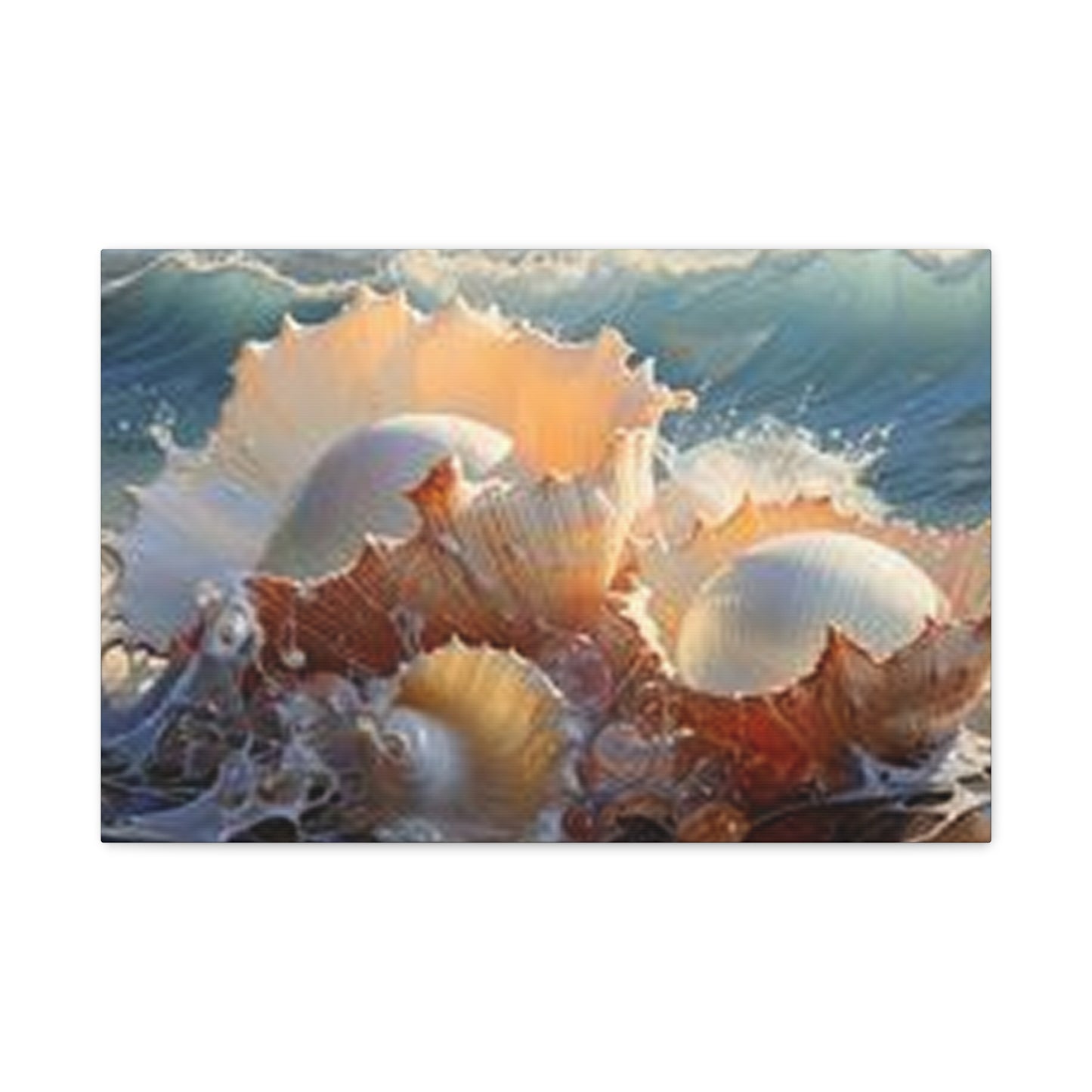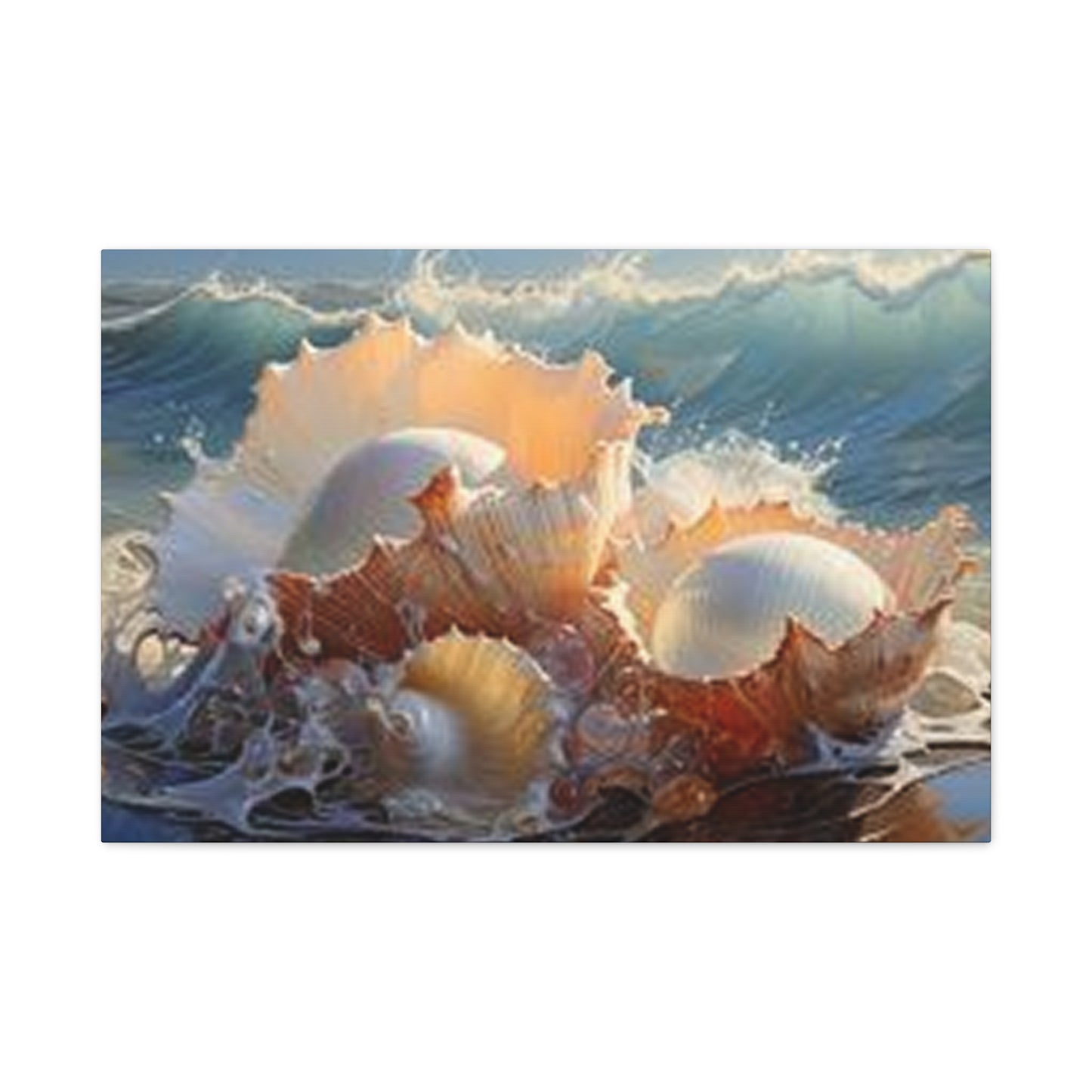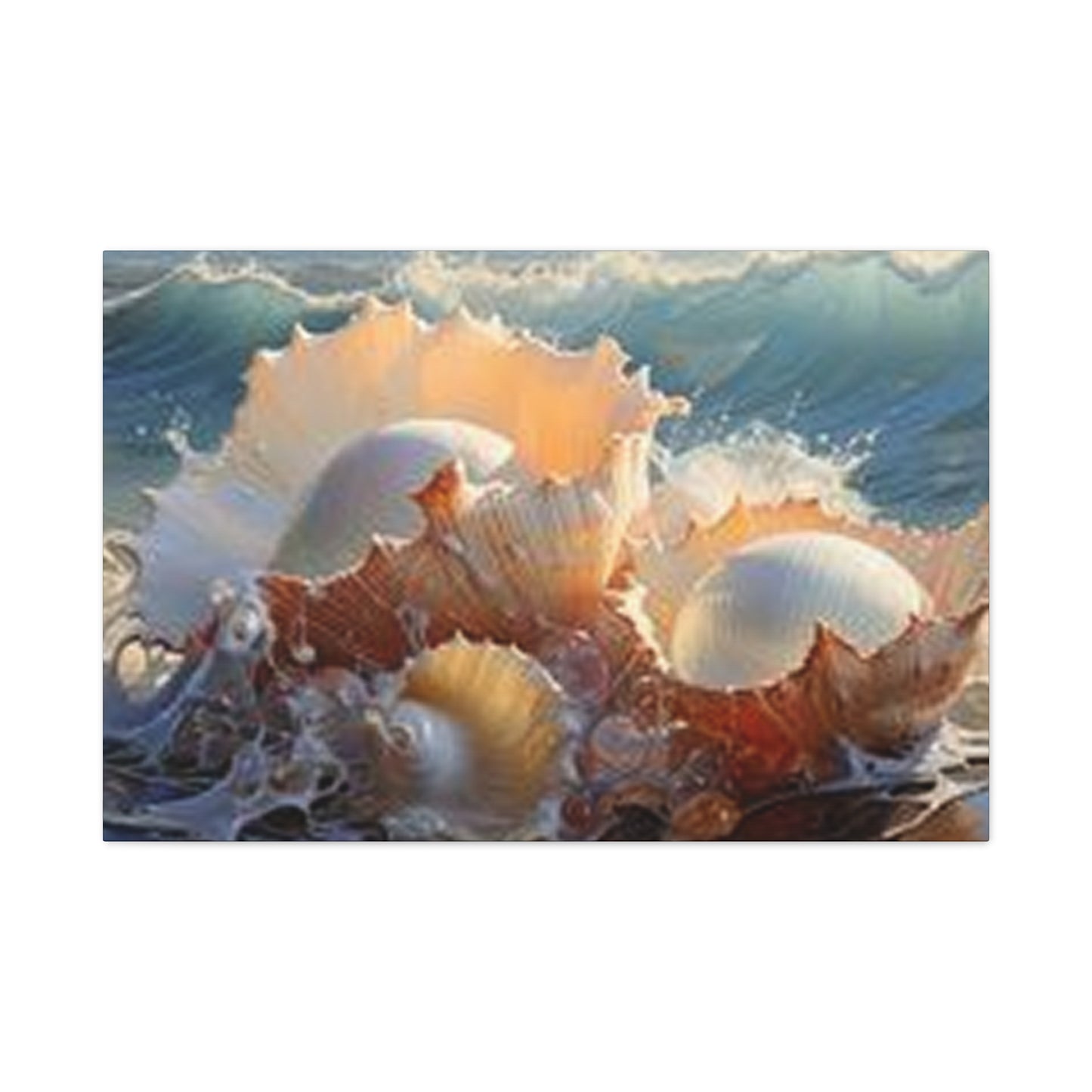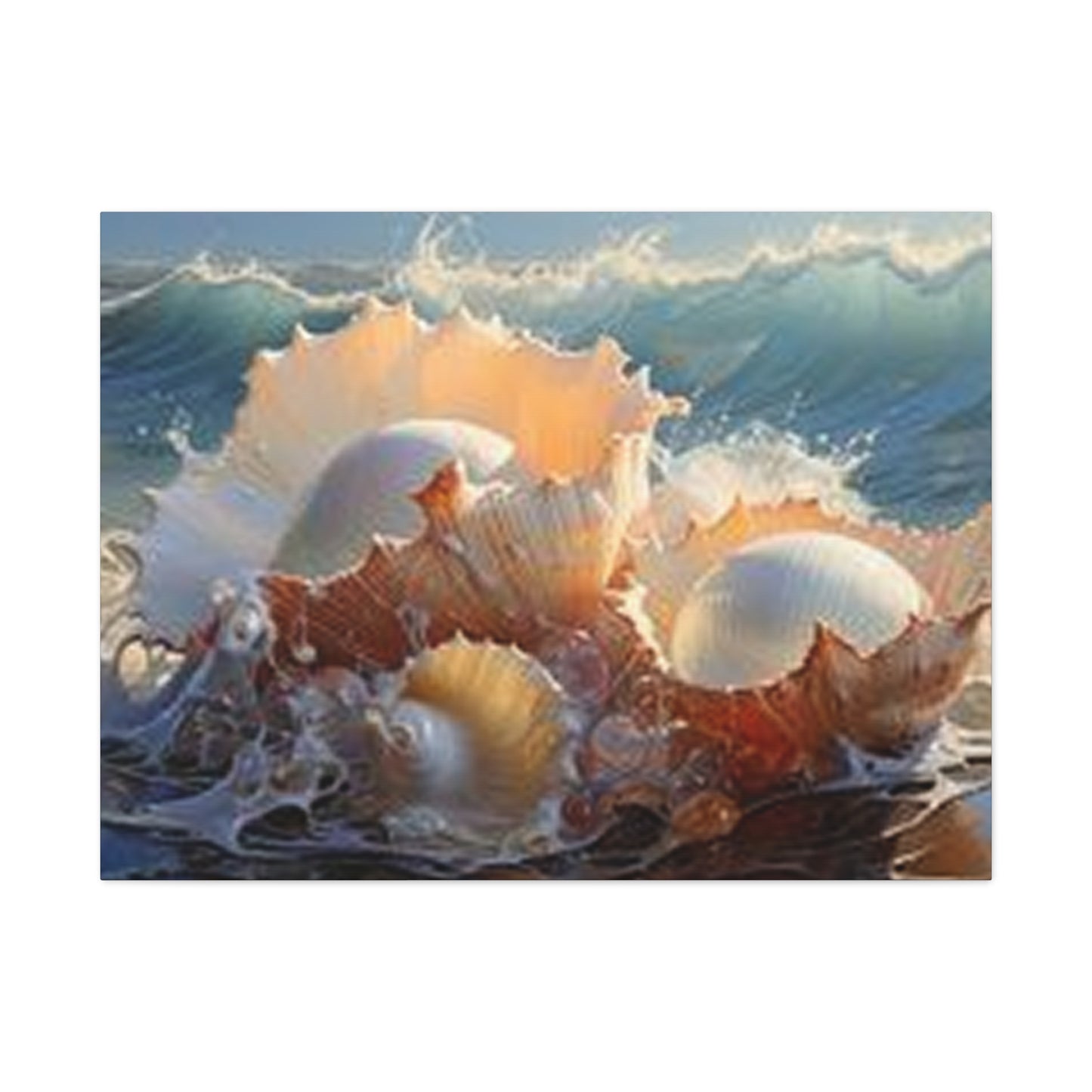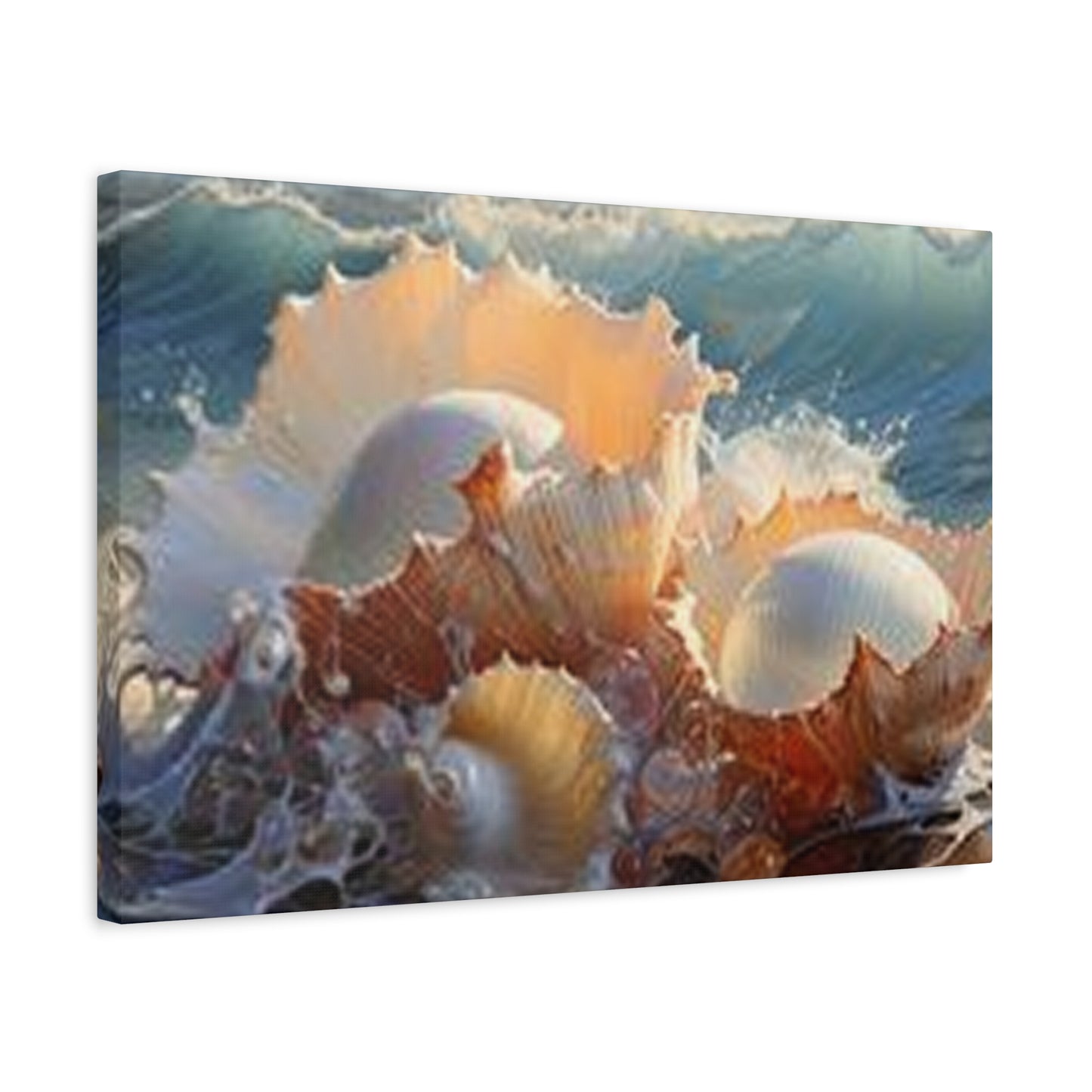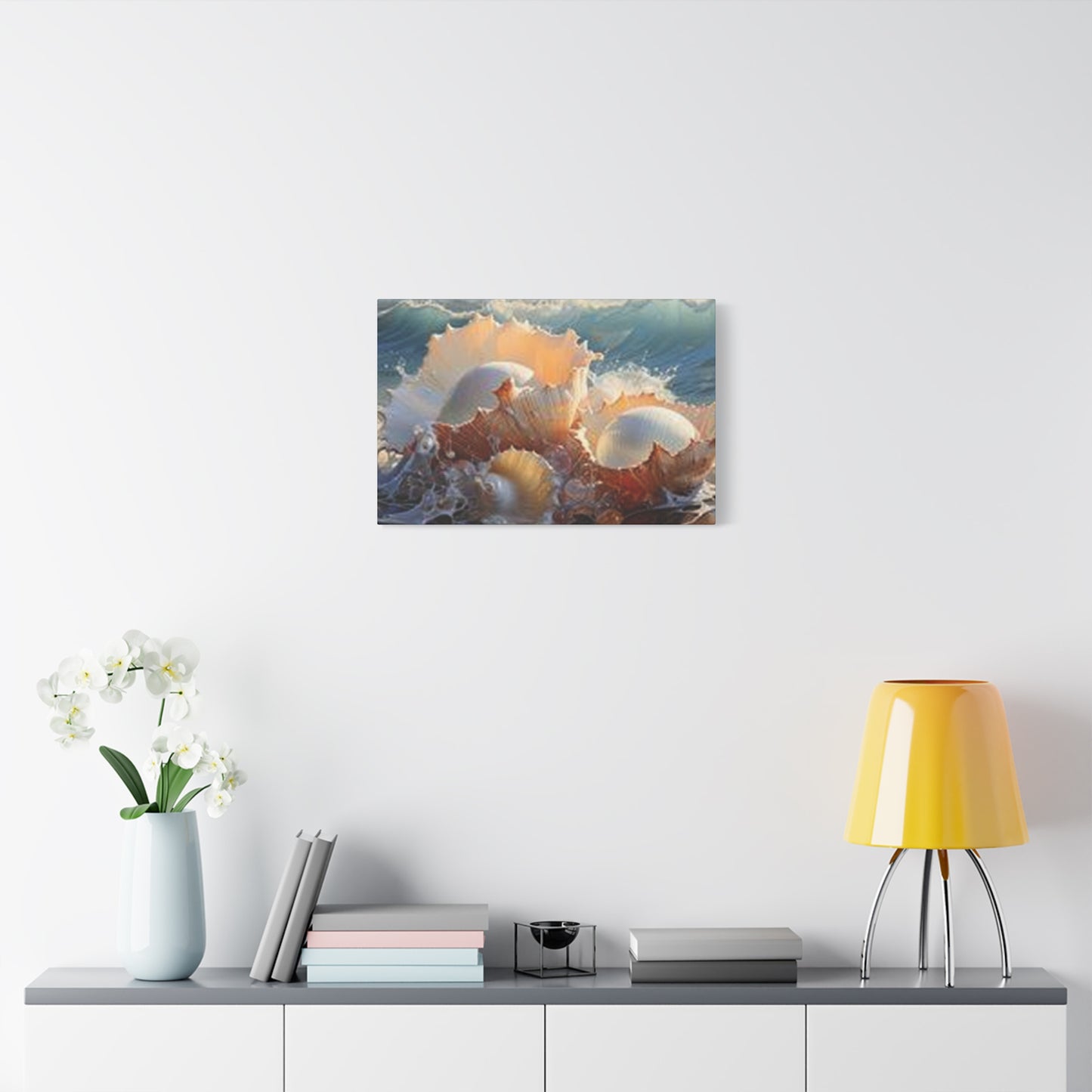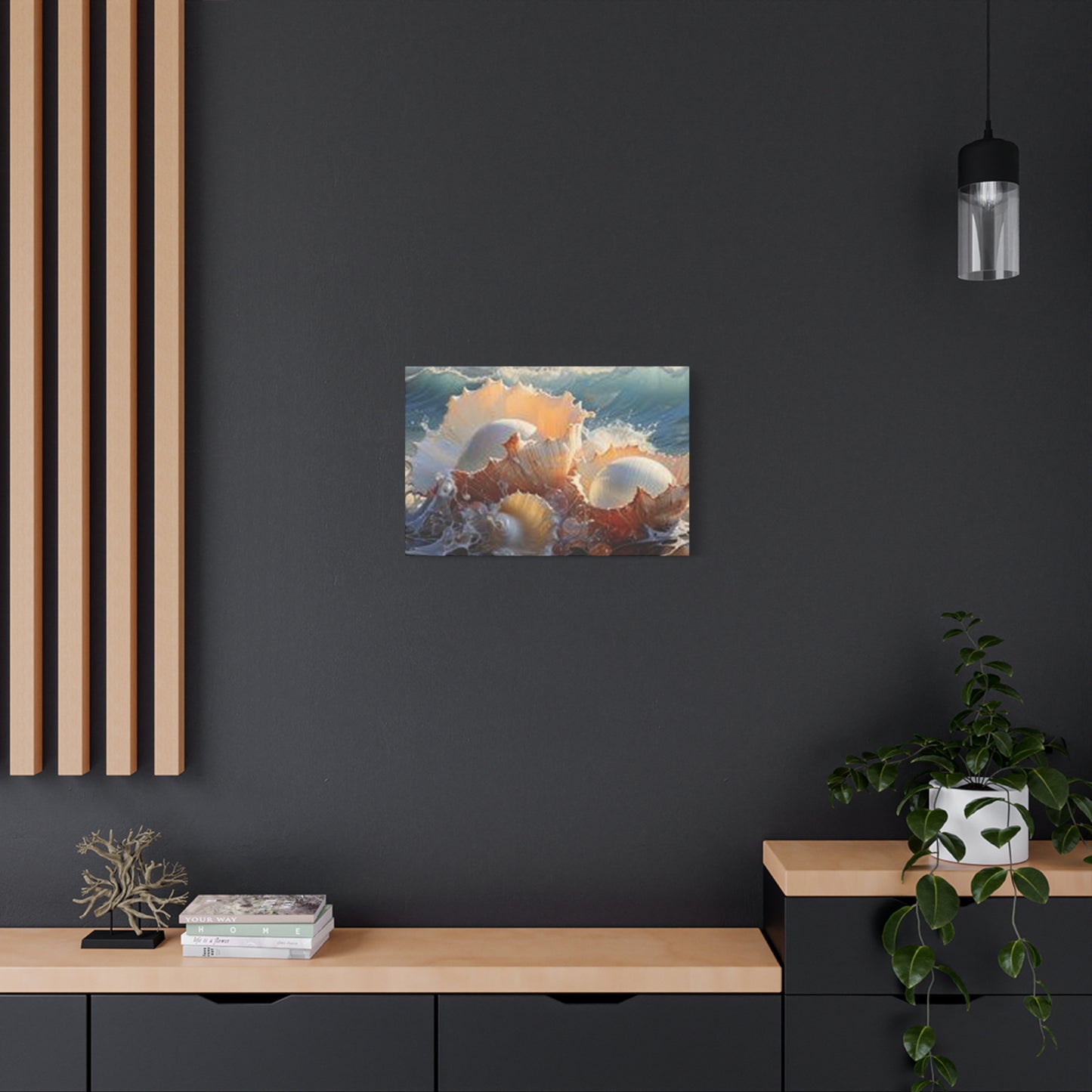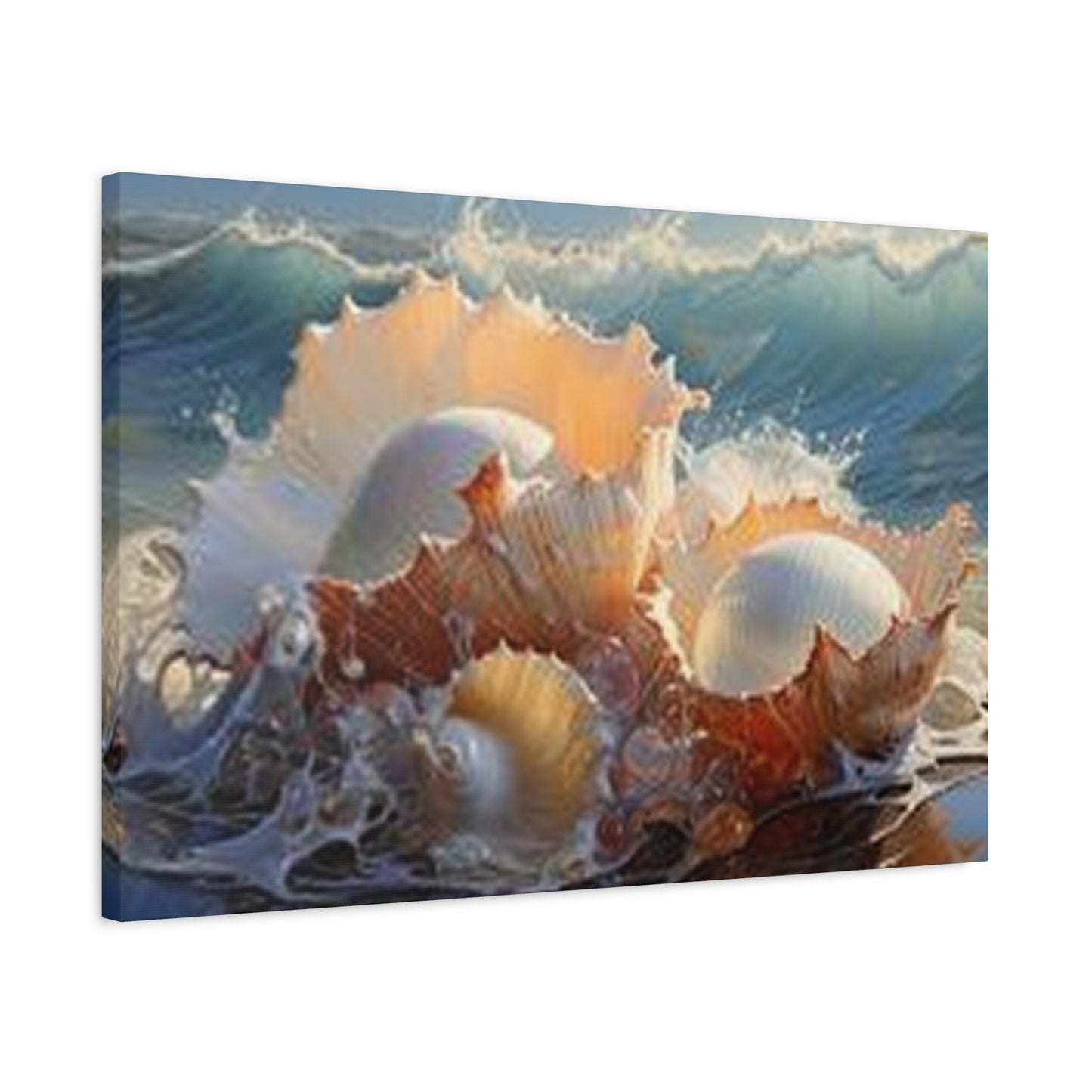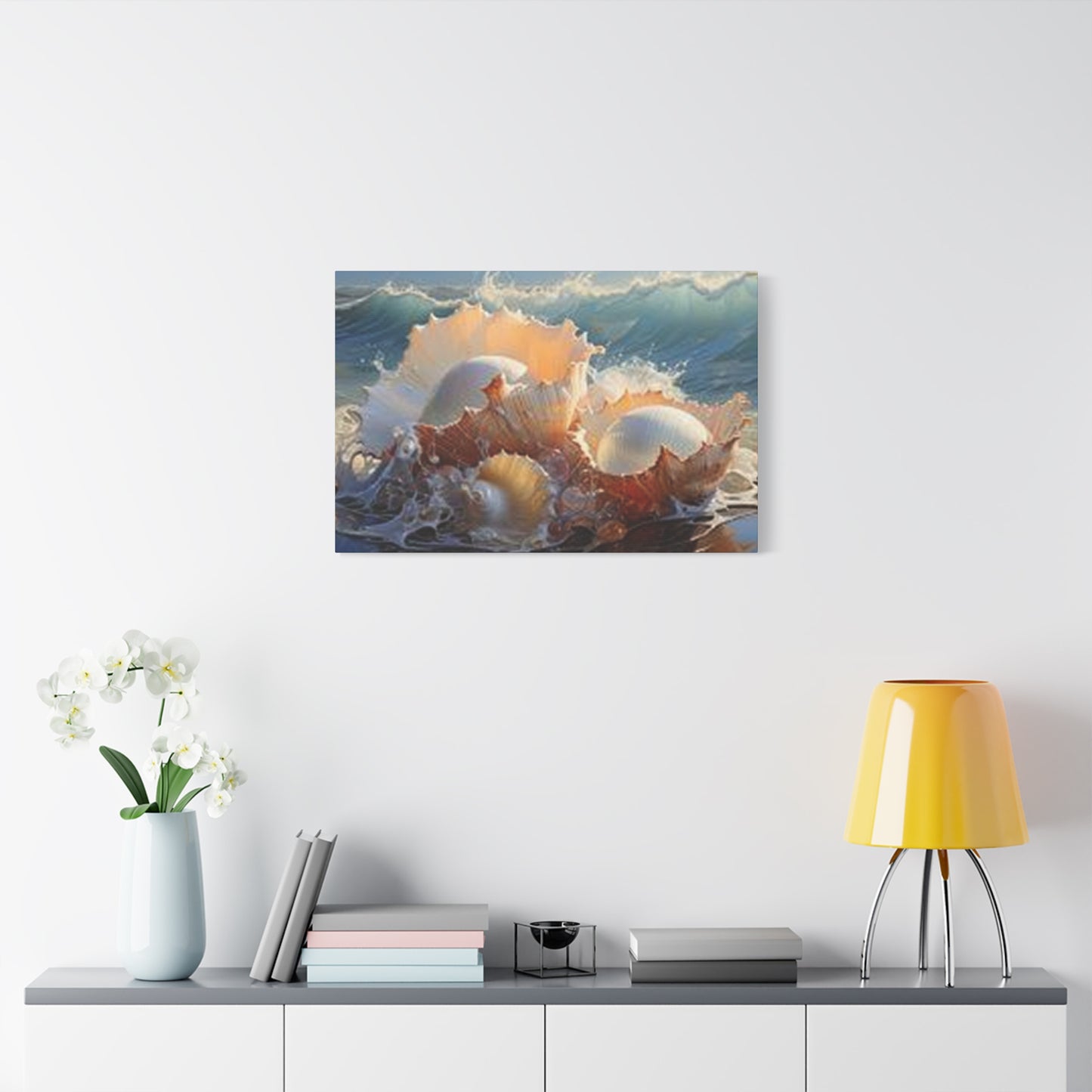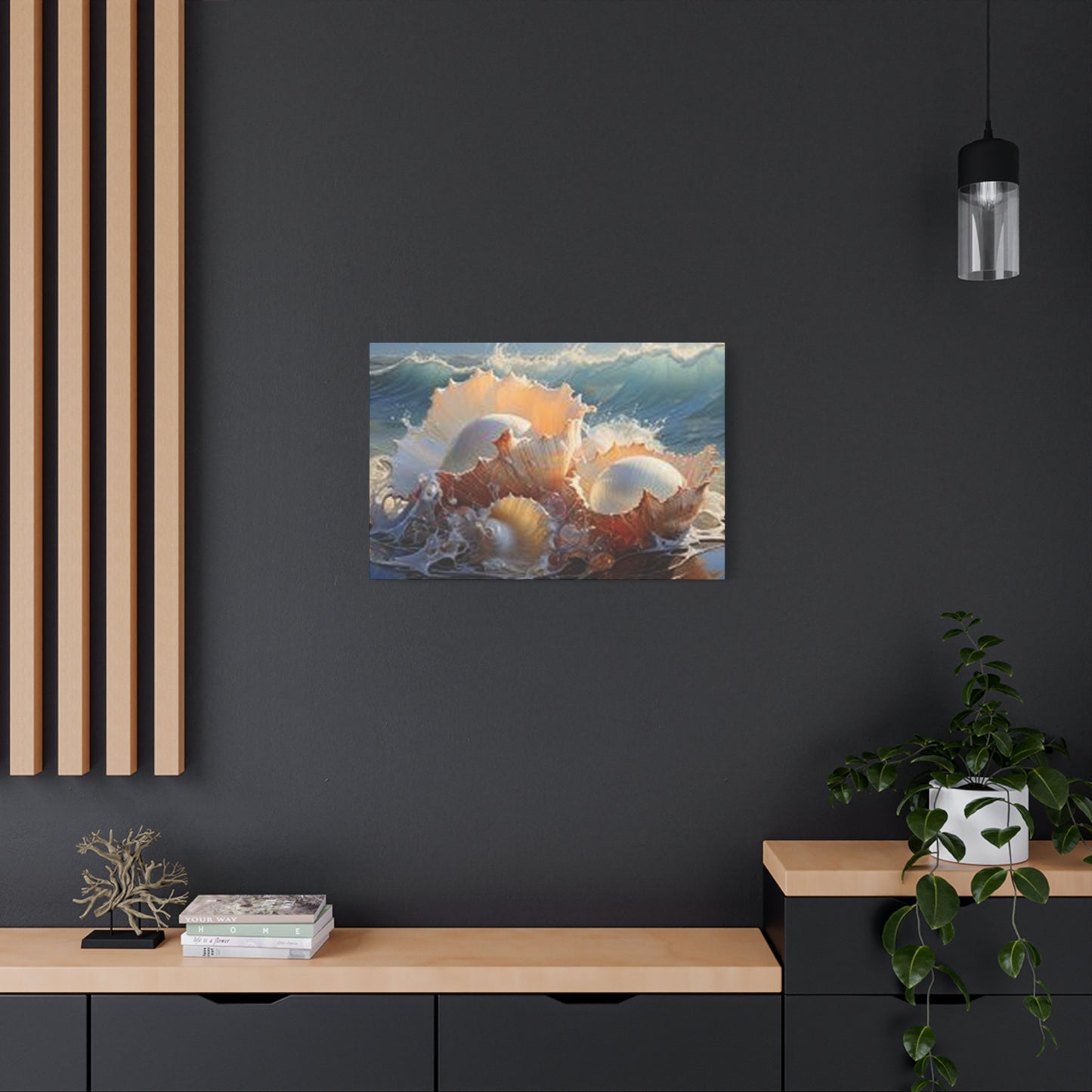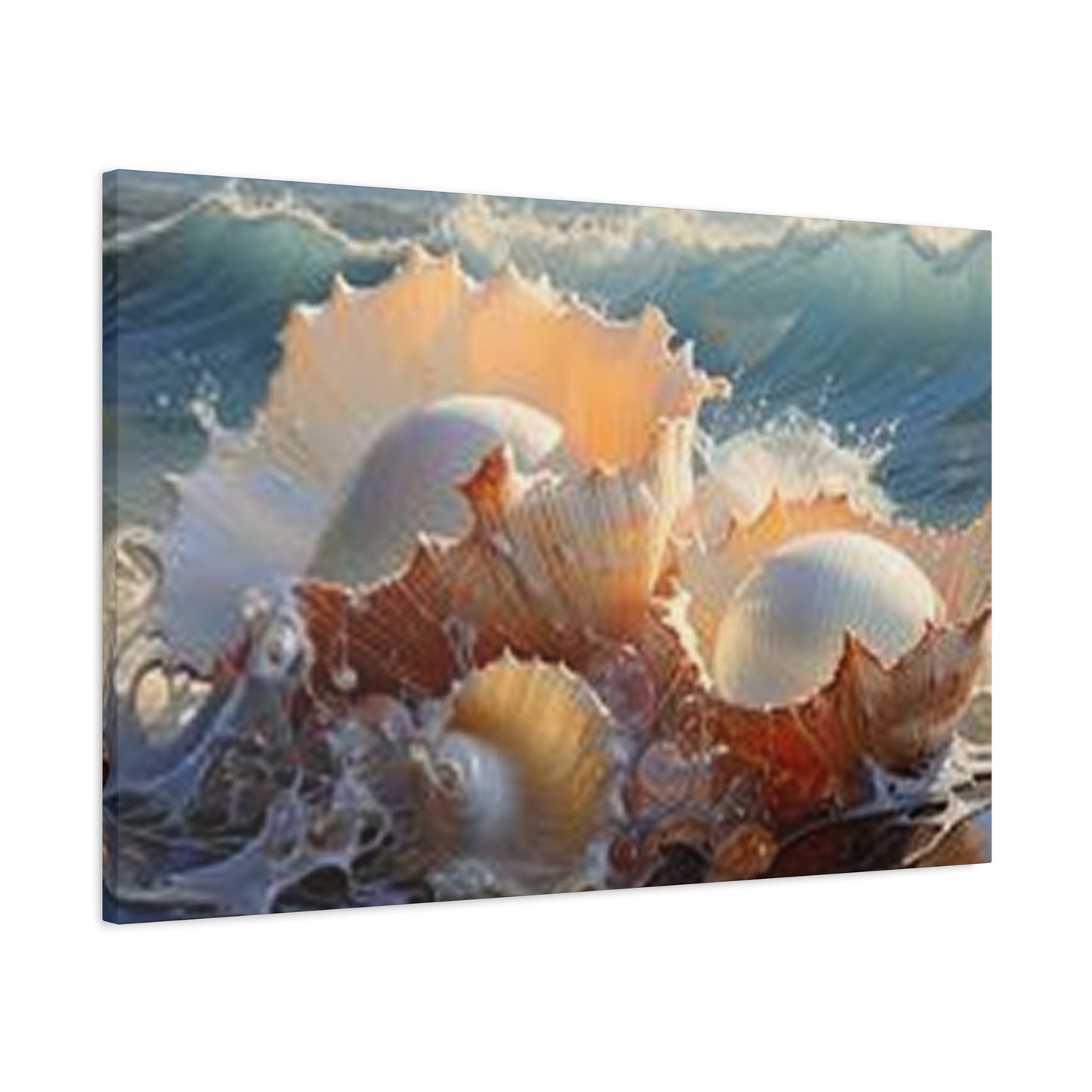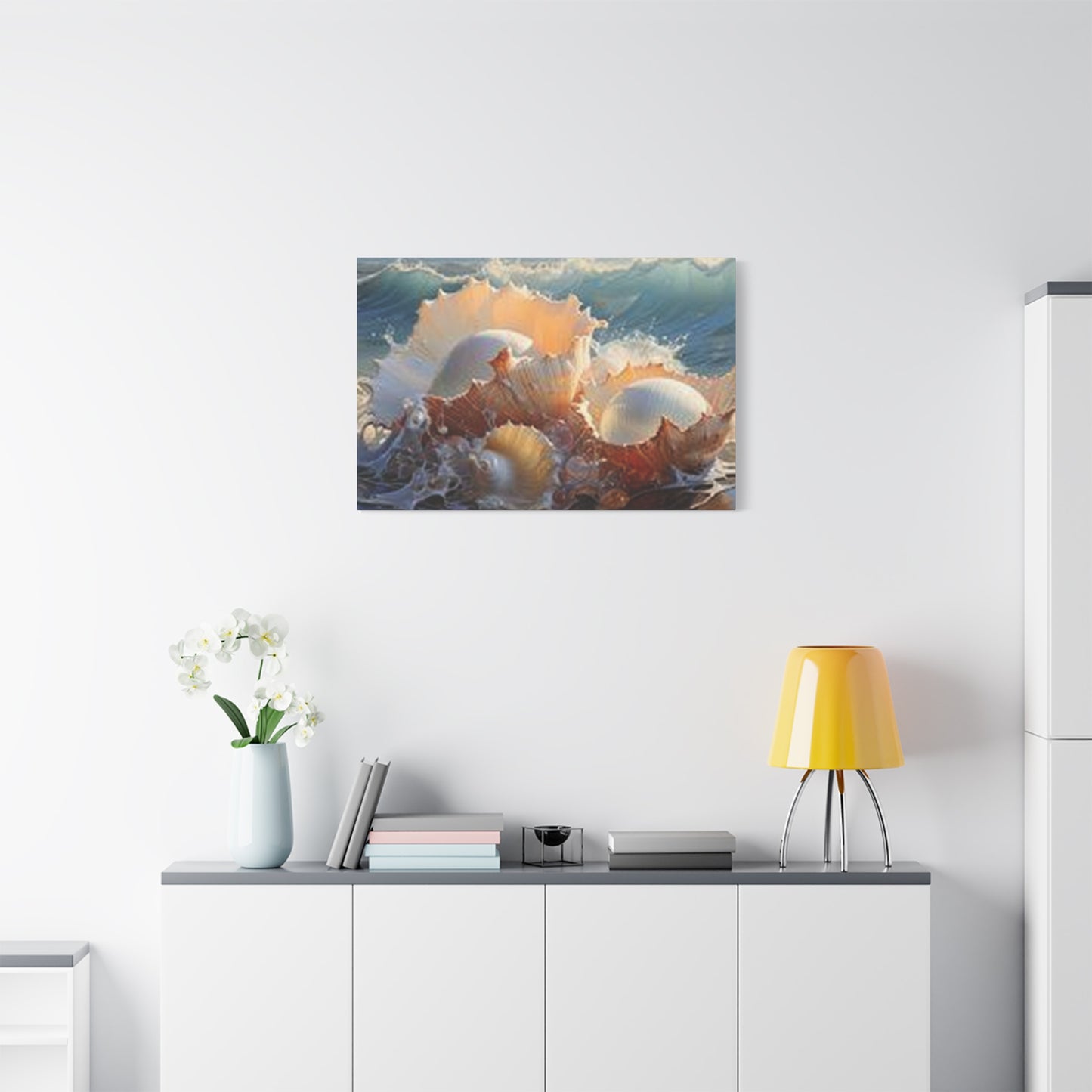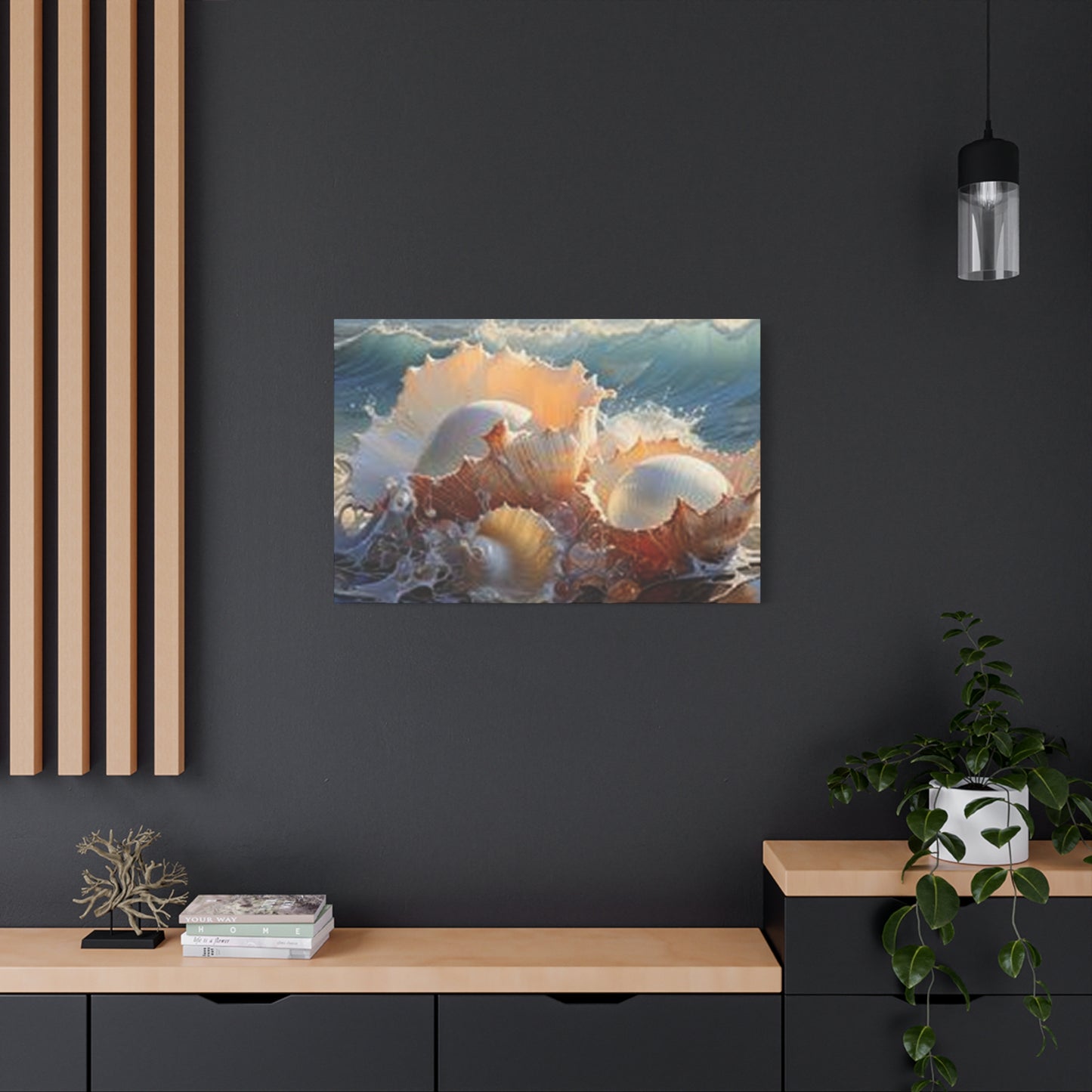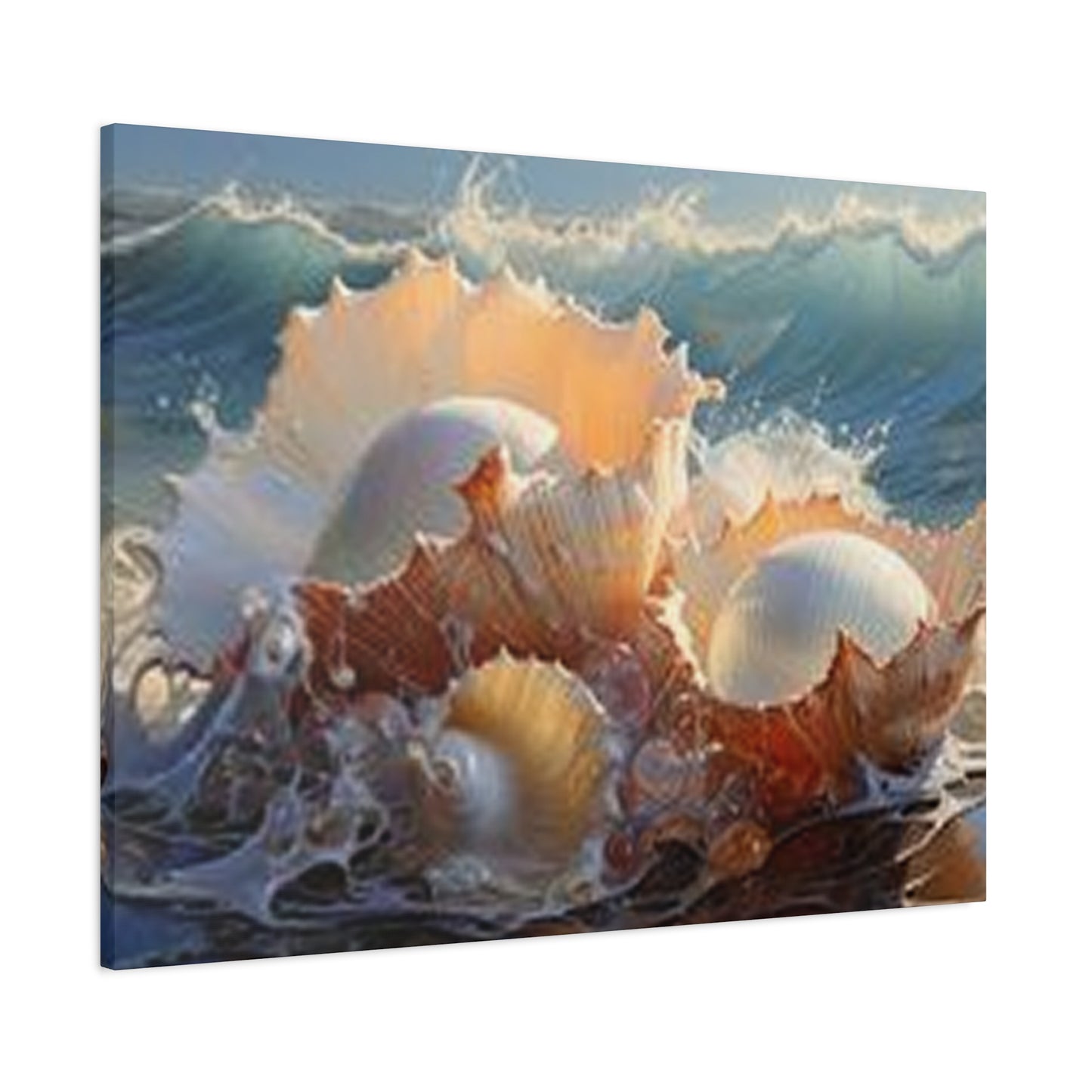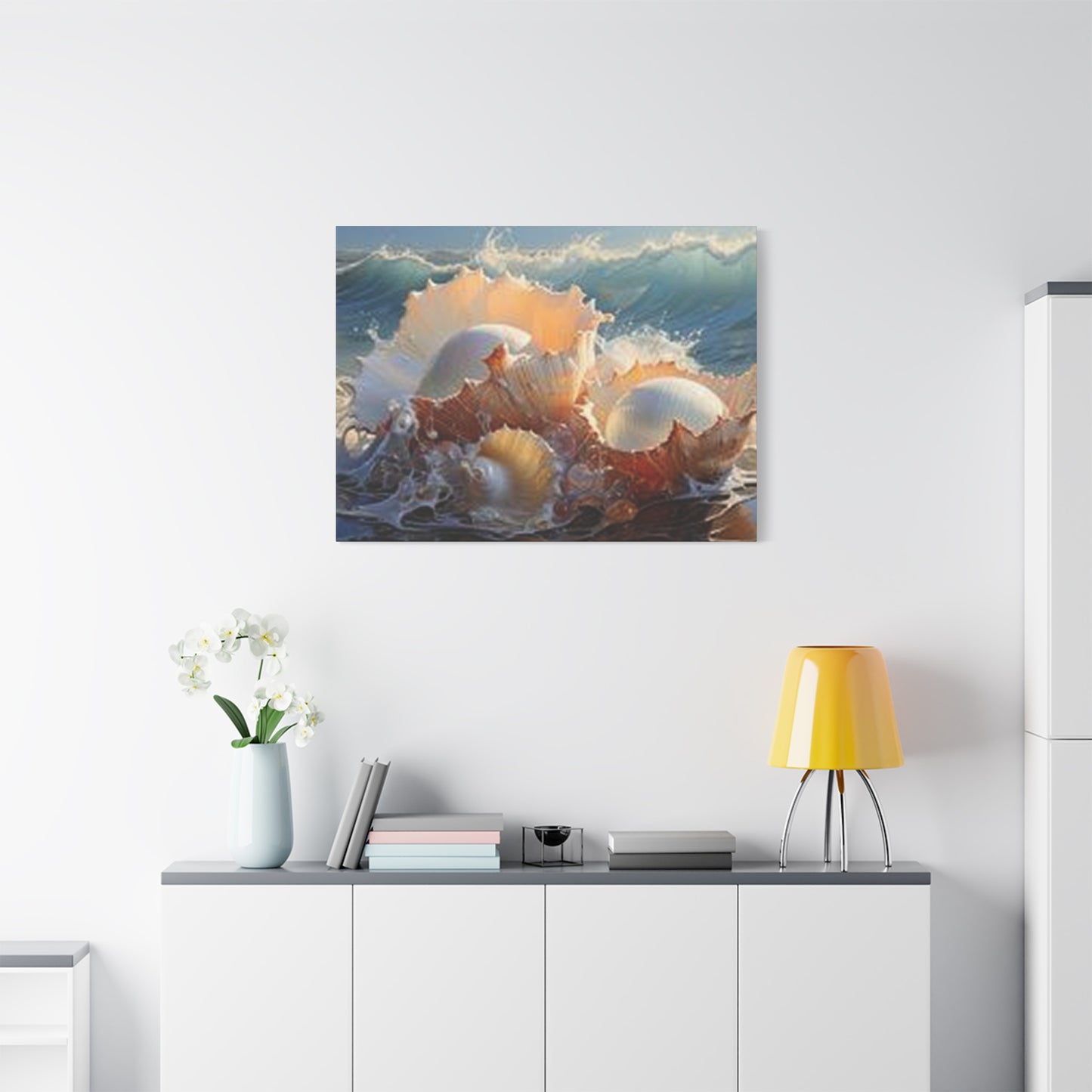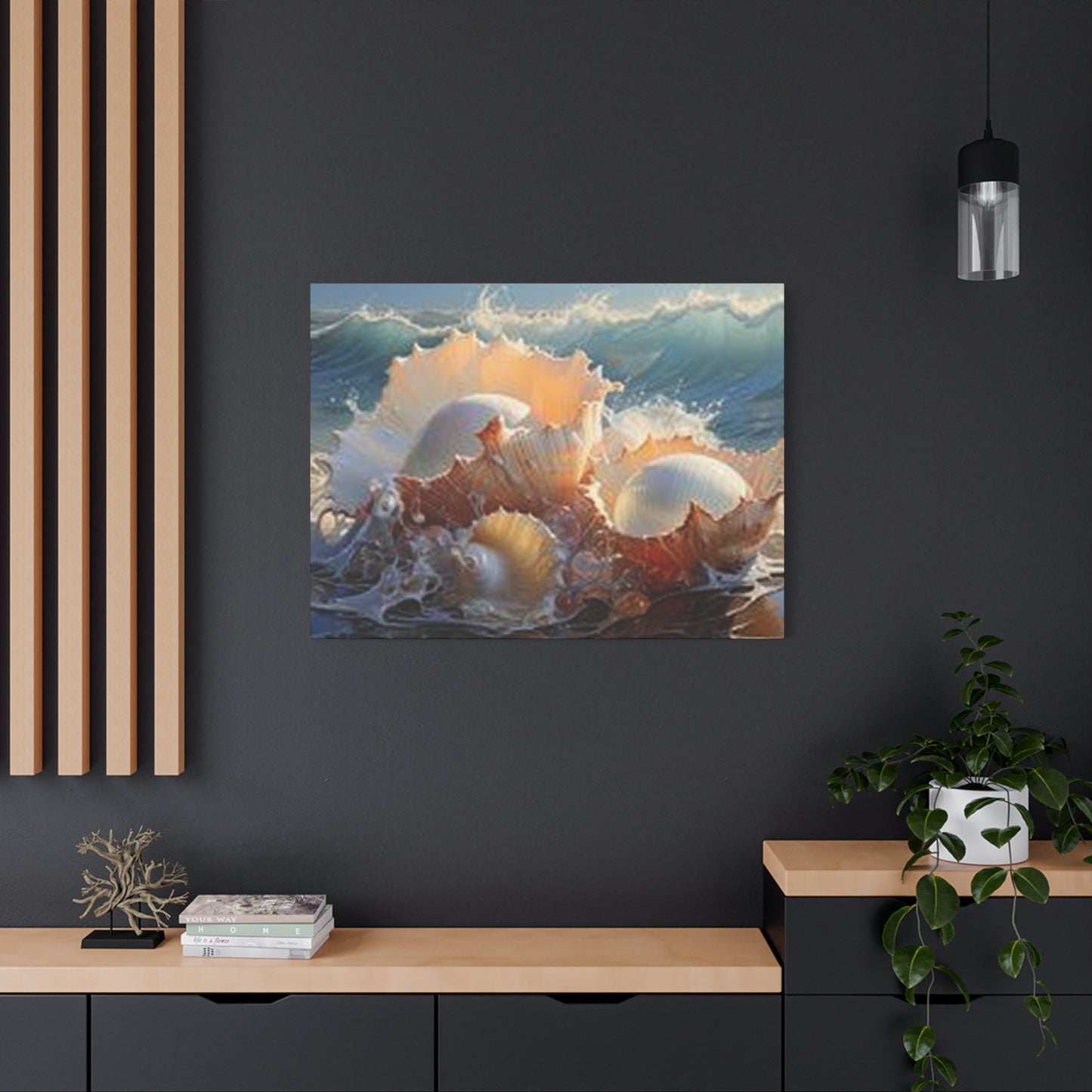The Complete Guide to Shells at Sea Shore Wall Art: Bringing Coastal Serenity to Your Home
The allure of coastal living has captivated homeowners and interior designers for generations. There is something inherently peaceful about incorporating elements from the seaside into our living spaces. Among the most popular choices for bringing the ocean's tranquility indoors is artwork featuring shells collected from sandy beaches. These decorative pieces offer more than just visual appeal; they create an atmosphere of relaxation and connection to nature that transforms any room into a serene retreat.
Canvas prints showcasing seashells have become increasingly sought after in modern interior design. These artworks capture the intricate beauty of marine specimens, from delicate spiral formations to robust clam varieties. Each piece tells a story of ocean waves, sandy coastlines, and the timeless rhythm of tides. When displayed prominently in homes, offices, or commercial spaces, these prints serve as constant reminders of peaceful beach vacations and the calming influence of coastal environments.
The popularity of beach-themed artwork extends beyond mere decoration. It represents a lifestyle choice, a desire to maintain connection with natural elements even in urban settings. For those who cannot live near the ocean, these visual representations provide daily doses of coastal inspiration. The textures, colors, and compositions found in quality seashell photography translate beautifully to canvas format, creating stunning focal points that enhance any interior design scheme.
Historical Significance of Marine Collectibles in Art
Throughout human history, shells have held profound cultural and artistic significance across civilizations. Ancient societies valued these marine treasures not only for their beauty but also for their practical applications and symbolic meanings. From currency to ceremonial objects, these ocean gifts have played diverse roles in human culture for thousands of years.
In classical art periods, marine life representations appeared frequently in paintings, mosaics, and sculptures. Renaissance artists incorporated shell imagery into their works, often using them as symbols of birth, femininity, and the divine. The famous painting featuring Venus emerging from a scallop shell exemplifies this tradition. Such historical precedents have influenced contemporary artists who continue exploring oceanic themes in their creative expressions.
The Victorian era witnessed a surge in shell collecting as a fashionable hobby among educated classes. Wealthy families displayed elaborate collections in curiosity cabinets, treating these natural specimens as precious artifacts worthy of careful preservation. This tradition of appreciating marine beauty for aesthetic purposes laid groundwork for today's thriving market in coastal artwork.
Modern artists draw upon this rich heritage when creating contemporary pieces. They combine traditional appreciation for natural forms with current artistic techniques and sensibilities. Digital photography and printing technologies have revolutionized how we capture and reproduce the intricate details of seashells, making museum-quality images accessible to wider audiences than ever before.
Benefits of Coastal Imagery
Research in environmental psychology consistently demonstrates that exposure to natural elements, particularly water scenes, produces measurable stress reduction in observers. The human brain responds positively to images of beaches, waves, and marine life, triggering relaxation responses similar to those experienced during actual beach visits. This phenomenon explains why coastal artwork has become so popular in spaces designed for relaxation and recuperation.
Colors associated with beach environments—soft blues, sandy beiges, seafoam greens—have inherently calming properties. These hues lower heart rate and blood pressure while promoting feelings of tranquility. When incorporated into living spaces through artwork, these colors create peaceful atmospheres conducive to rest and rejuvenation. Seashell canvas prints naturally incorporate this beneficial color palette, making them ideal choices for bedrooms, meditation spaces, and areas designated for unwinding.
The organic shapes and patterns found in shells engage our visual perception in particularly satisfying ways. Spiral formations follow mathematical sequences that appear throughout nature, creating inherent aesthetic appeal that humans find pleasing on an almost subconscious level. These natural geometries provide visual interest without overwhelming the senses, striking a perfect balance between stimulation and serenity.
For individuals dealing with anxiety or stress-related conditions, surrounding themselves with reminders of peaceful natural settings can serve as valuable therapeutic tools. Many mental health professionals recommend incorporating nature-inspired artwork into living spaces as part of comprehensive wellness strategies. The gentle presence of seashell imagery offers continuous subtle reinforcement of calm, helping maintain emotional equilibrium throughout daily routines.
Understanding Canvas Print Quality Standards
The quality of canvas prints varies dramatically based on materials, printing processes, and production standards employed by manufacturers. Discerning buyers should understand these factors to make informed purchasing decisions. Superior canvas materials feature tight weaves that prevent image distortion and ensure longevity. Cotton and linen blends offer excellent durability while providing appropriate texture that enhances photographic reproductions.
Professional-grade printing processes utilize pigment-based inks rather than dye-based alternatives. Pigment inks resist fading significantly better than dyes, maintaining color accuracy for decades when properly displayed. This distinction becomes particularly important for artwork featuring subtle color variations, such as the delicate pearlescent qualities of certain shell varieties. Investment in quality printing ensures that the beauty captured in original photography remains vibrant throughout the artwork's lifespan.
Stretching and mounting techniques greatly impact final presentation. Quality manufacturers stretch canvas tautly over solid wooden frames, eliminating wrinkles and ensuring flat, professional appearance. Frame depth affects visual impact; gallery-wrapped canvases with deeper frames create dimensional presence that shallow alternatives cannot match. Corner construction requires particular attention, as poorly executed corners compromise overall structural integrity.
Protective coatings applied to finished prints serve dual purposes: they shield artwork from environmental damage while enhancing visual depth. UV-resistant varnishes prevent sun damage that would otherwise cause gradual color deterioration. These protective layers also facilitate cleaning, allowing owners to gently remove dust and light soil without damaging underlying prints. When evaluating potential purchases, inquiring about protective treatments provides insight into manufacturer commitment to quality and longevity.
Popular Seashell Species Featured in Artwork
Conch shells, with their distinctive spiral formations and vibrant pink interiors, rank among the most recognizable subjects in coastal artwork. These impressive specimens can grow quite large, making them visually striking focal points. Artists appreciate how light plays across conch surfaces, creating gradients from pale cream exteriors to deep rose-tinted inner chambers. The sculptural quality of conch shells translates exceptionally well to photographic reproduction, maintaining dimensional appearance even in two-dimensional format.
Scallop shells offer different aesthetic qualities with their fan-shaped ridges radiating from central hinges. These bivalves come in various sizes and color combinations, from pure white to orange and purple variations. Their symmetrical forms have inspired artists and designers for centuries, appearing in architecture, logos, and decorative motifs worldwide. In canvas artwork, scallops often appear individually or arranged in pleasing compositions that emphasize their geometric perfection.
Sand dollars present unique circular forms decorated with distinctive star patterns. These flat specimens photograph beautifully, especially when captured against contrasting backgrounds. Their delicate nature and intricate surface details make them popular subjects for close-up photography. Artists often highlight the peaceful symbolism associated with sand dollar discoveries, as beachcombers consider finding intact specimens particularly fortunate occurrences.
Nautilus shells represent perhaps the most mathematically fascinating specimens found in coastal artwork. Their internal chambers follow precise logarithmic spirals that demonstrate natural mathematical principles. When sectioned to reveal interior architecture, nautilus shells display breathtaking complexity that captivates viewers. Photography showcasing these internal structures creates dramatic artwork that appeals to both nature enthusiasts and those appreciating geometric beauty.
Smaller varieties including periwinkles, augers, and coquinas often appear in grouping compositions. These diminutive specimens allow artists to create texture-rich arrangements featuring multiple shapes, sizes, and colors. Clustered presentations evoke memories of beachcombing adventures, where discovering numerous small treasures provides as much joy as finding single impressive specimens. Such compositions offer visual complexity that rewards extended viewing.
Color Palettes in Beach-Inspired Artwork
Natural seashell coloration spans remarkable spectrum from brilliant whites to deep browns, with countless variations between extremes. Pure white specimens create clean, minimalist aesthetic perfect for contemporary interiors. These light-toned pieces brighten spaces while maintaining subtle presence that complements rather than dominates surrounding decor. White shell artwork pairs beautifully with neutral color schemes, adding texture without introducing competing hues.
Warm tones including creams, beiges, and tans evoke sandy beaches and sun-bleached driftwood. These earthy colors create cozy, inviting atmospheres in living spaces. Canvas prints featuring warm-toned shells work particularly well in rooms decorated with natural materials like wood and stone. The organic color harmony between artwork and natural textures creates cohesive design stories that feel authentic and unpretentious.
Cool blue and green variations appear in certain shell species and often feature prominently in seascape backgrounds. These oceanic hues reinforce coastal themes while providing chromatic connection to water elements. Artists frequently incorporate graduated blue backgrounds that suggest depth and distance, placing shell subjects against infinite ocean horizons. Such compositions create contemplative mood appropriate for spaces dedicated to reflection and relaxation.
Pink and coral tones add unexpected warmth to coastal color schemes. These romantic hues appeal particularly to those designing feminine spaces or seeking alternatives to traditional blue-and-white beach themes. Photography capturing the rosy interiors of conch shells or sunset-tinted compositions creates artwork with distinctive personality that stands apart from conventional coastal imagery.
Dramatic contrast treatments showcase shells against dark backgrounds, creating sophisticated presentations suitable for formal settings. Black or charcoal backgrounds make shell details pop with striking clarity, emphasizing texture and form. These high-contrast approaches suit modern and contemporary design aesthetics, proving that coastal themes can appear elegant and refined rather than casual and informal.
Considerations for Different Spaces
Selecting appropriate artwork dimensions requires careful consideration of room proportions and furniture arrangements. Oversized pieces create bold statements suitable for expansive walls in living rooms or dining areas. Large-format canvas prints measuring several feet across command attention and serve as primary decorative elements around which additional design choices revolve. When featuring detailed shell photography, substantial size allows viewers to appreciate intricate textures and subtle color variations.
Medium-sized prints offer versatility for various applications throughout homes. These moderately proportioned pieces work well above bedroom headboards, in hallways, or grouped as part of gallery walls. Their manageable dimensions facilitate arrangement flexibility while still providing sufficient visual impact to anchor decorative schemes. Most homeowners find medium formats most practical for typical residential spaces.
Small canvas prints excel in creating layered, collected looks when displayed in multiples. Series of coordinating images arranged in grids or scattered configurations add visual interest to walls without overwhelming rooms. Compact formats suit tight spaces like bathrooms, home offices, or cozy reading nooks where large artwork would feel disproportionate. Small prints also offer economical entry points for those beginning to build coastal art collections.
Vertical orientations suit narrow wall spaces between windows or beside doorways. Portrait-format compositions featuring vertical arrangements of shells or tall single specimens fit naturally in these challenging locations. Horizontal formats better complement furniture pieces like sofas and console tables, where width exceeds height. Matching artwork orientation to underlying furniture proportions creates visual harmony.
Square formats provide balanced composition options that work in various configurations. These neutral proportions adapt easily to different hanging arrangements and suit both traditional and contemporary settings. Square canvas prints can stand alone or group effectively in symmetrical or asymmetric patterns depending on overall design intentions.
Framing Options and Presentation Styles
Gallery wrap technique stretches canvas around frame edges, eliminating need for additional framing materials. This modern presentation style creates clean, contemporary appearance with artwork extending continuously around sides. Gallery wrapping suits minimalist design preferences and allows pieces to hang flush against walls. Deeper stretcher bars enhance dimensional presence, creating shadow effects that add visual interest.
Traditional framing adds formal polish suitable for classic interiors. Wooden frames in natural finishes complement coastal themes while providing finished appearance. Frame selection significantly impacts overall presentation; weathered wood suggests rustic beach cottages while sleek metal frames convey modern sophistication. Matting between image and frame creates breathing room that prevents artwork from feeling cramped within boundaries.
Float mounting presents canvas slightly separated from backing materials, creating subtle shadow effects. This technique adds dimension while maintaining contemporary aesthetic. Float-mounted pieces appear to hover against walls, drawing attention to craftsmanship and quality. The technique works particularly well with square and smaller rectangular formats.
Multi-panel installations divide single images across multiple canvases, creating dynamic presentations. Triptychs and larger multi-piece arrangements add movement and contemporary flair to traditional coastal subjects. Spacing between panels introduces negative space that enhances overall composition. These segmented presentations work especially well in larger rooms where single-panel alternatives might appear overwhelmed by surrounding space.
Mixed media presentations combine canvas prints with three-dimensional elements like actual shells or driftwood. These hybrid creations add tactile dimension to visual imagery, creating interactive quality. While canvas prints alone remain most popular choice, mixed media options appeal to those seeking truly unique decorative statements.
Placement Strategies Throughout Your Home
Living room display opportunities abound for coastal artwork. Large walls above sofas provide ideal locations for substantial statement pieces. The visual weight of sizeable canvas prints balances furniture below, creating cohesive arrangements. Consider sight lines from various seating positions to ensure artwork remains visible from multiple vantage points. Living rooms typically receive ample natural light, which can enhance but also potentially damage artwork over time, making UV protection crucial.
Bedroom sanctuaries benefit particularly from calming coastal imagery. Positioning seashell artwork where it catches morning light creates gentle awakening experiences. Above-headboard placement provides focal points visible from bed, establishing peaceful atmospheres conducive to restful sleep. Bedrooms often feature more personal decorating choices, allowing for experimental color combinations or unconventional arrangements that might feel too bold for public spaces.
Bathroom environments naturally accommodate beach themes. Moisture considerations require properly sealed canvas prints rated for humid conditions. Smaller formats typically suit bathroom proportions better than oversized alternatives. Groupings of related images create cohesive looks in these intimate spaces. The practical connection between bathrooms and water makes coastal artwork feel particularly appropriate.
Home offices benefit from artwork that promotes calm focus without proving distracting. Subtle shell compositions in neutral tones provide visual interest during work breaks while maintaining professional appearance. Positioning artwork opposite desk locations allows for brief visual respites that refresh attention spans. Coastal themes in work environments can reduce stress levels, improving productivity and job satisfaction.
Entryways and hallways present opportunities for creating strong first impressions. Gallery walls featuring multiple coordinated pieces work well in these transitional spaces, providing visual interest along pathways. Lighting considerations become particularly important in hallways, which often lack natural illumination. Strategic artificial lighting can dramatically enhance artwork presentation in these areas.
Lighting Techniques for Artwork Enhancement
Natural daylight provides ideal illumination for appreciating color accuracy and subtle details in photographic artwork. However, direct sunlight poses significant fading risks even with UV-protective coatings. Positioning artwork where it receives ambient natural light without direct sun exposure creates optimal viewing conditions while preserving longevity. North-facing walls in northern hemisphere locations typically receive consistent indirect light ideal for displaying valuable pieces.
Picture lights mounted directly above frames provide focused illumination perfect for highlighting artwork. These specialized fixtures direct light downward across canvas surfaces, minimizing glare while ensuring even coverage. Adjustable picture lights allow fine-tuning of illumination angles to account for viewing positions and surrounding lighting conditions. Choosing warm or cool light temperatures impacts how colors appear, with warm light enhancing cream and beige tones while cool light emphasizes blues and grays.
Track lighting systems offer flexibility for illuminating multiple artworks or adjusting as collections evolve. These versatile systems allow repositioning of individual fixtures to accommodate changing arrangements. When using track lighting, position fixtures at approximately 30-degree angles to artwork surfaces to minimize glare and maximize even illumination across entire images.
Recessed ceiling fixtures provide ambient room lighting that indirectly illuminates artwork. While less dramatic than dedicated picture lighting, recessed fixtures create overall environment where artwork appears naturally integrated into space. Dimmer switches allow adjusting light levels to suit different times of day and activities, providing flexibility that enhances living quality.
Smart lighting systems enable programming illumination schedules and adjusting color temperatures via smartphone controls. These advanced solutions allow highlighting artwork during entertainment situations while reducing unnecessary light exposure during absent hours. As technology advances, automated systems increasingly accommodate artistic display while promoting energy efficiency.
Design Styles That Complement Coastal Art
Coastal design styles naturally pair with seashell artwork, creating cohesive nautical atmospheres. This approach combines white and blue color schemes with natural textures and maritime accessories. Furniture featuring weathered finishes and casual upholstery supports relaxed beach house aesthetic. Seashell canvas prints serve as anchoring elements that reinforce thematic consistency throughout spaces decorated in coastal style.
Modern farmhouse interiors blend rustic elements with contemporary clean lines, creating popular hybrid aesthetic. Coastal artwork fits surprisingly well within this style when presented in appropriate frames and colors. Neutral-toned shell photography complements farmhouse preferences for natural materials and organic forms. The combination creates fresh interpretation of country living that feels current rather than dated.
Contemporary minimalist spaces utilize coastal artwork as controlled injections of organic content within otherwise spare environments. Single large-format pieces against white walls create powerful statements without cluttering. The simplicity of individual shell specimens photographed against plain backgrounds aligns perfectly with minimalist principles of reduction and essential form.
Tropical design schemes incorporate coastal elements alongside bolder colors and patterns. While seashell artwork might initially seem too subtle for tropical maximalism, carefully selected pieces featuring vibrant specimens or dramatic compositions can hold their own against exuberant surroundings. The key involves choosing images with sufficient color saturation and visual complexity to register within busy environments.
Traditional formal interiors accommodate coastal artwork when presented with appropriate framing and restraint. Classic wooden frames and symmetrical arrangements allow shell imagery to appear in otherwise conventional settings without creating discord. The timeless beauty of natural forms transcends style boundaries, making quality seashell artwork adaptable to surprising range of design approaches.
Caring for Canvas Art Investments
Routine dusting prevents accumulation that dulls appearance over time. Soft microfiber cloths or specialized art dusters remove surface debris without scratching protective coatings. Dusting should occur at least monthly, more frequently in areas with high air circulation or open windows. Gentle brushing motions following canvas weave directions prevent fiber damage while maintaining pristine appearance.
Occasional deeper cleaning addresses stubborn soil and environmental residue. Slightly dampened cloths using distilled water can safely remove most deposits without damaging prints or coatings. Testing cleaning methods on inconspicuous areas before addressing visible regions prevents accidental damage. Avoid commercial cleaning products unless specifically formulated for canvas artwork, as chemicals in household cleaners can degrade inks and protective layers.
Environmental controls protect artwork from accelerated deterioration. Maintaining consistent humidity levels prevents canvas expansion and contraction that can cause cracking or warping. Ideal humidity ranges between 40-60 percent, achievable through humidifiers or dehumidifiers depending on local climate. Temperature stability similarly prevents material stress, with moderate consistent temperatures preferred over fluctuating extremes.
Avoiding direct sunlight prevents premature fading even when UV-protective coatings exist. Rotating displayed pieces periodically distributes light exposure across collections, ensuring no single artwork experiences disproportionate environmental stress. For particularly valuable pieces, installing window films or using curtains during peak sunlight hours provides additional protection.
Professional conservation services can restore damaged artwork or provide protective treatments beyond consumer capabilities. For valuable or sentimental pieces showing age-related deterioration, consulting certified art conservators ensures appropriate intervention that preserves rather than inadvertently damages. Prevention remains more cost-effective than restoration, making proactive care practices worthwhile investments.
Photography Techniques Behind Quality Images
Macro photography captures intricate shell details invisible to casual observation. Specialized lenses designed for extreme close-up work reveal textures, patterns, and subtle color variations that transform familiar objects into abstract compositions. The technical skill required for effective macro photography ensures that quality canvas prints truly showcase subjects rather than merely documenting them.
Lighting techniques dramatically impact how shells appear in photographs. Soft diffused illumination reveals subtle contours and prevents harsh shadows that obscure details. Many professional shell photographers employ light tents or specialized diffusers to achieve even illumination across entire subjects. Backlighting can create dramatic effects, especially with translucent specimens, revealing internal structures and creating luminous qualities.
Background selection frames subjects and establishes mood. Clean neutral backgrounds emphasize shell forms without distraction, creating minimalist compositions suitable for contemporary spaces. Textured backgrounds suggesting sand or weathered wood provide context and enhance coastal themes. Carefully chosen backgrounds complement rather than compete with primary subjects.
Composition principles including rule of thirds, leading lines, and negative space apply equally to shell photography as any artistic medium. Thoughtful arrangement of elements within frame creates balanced pleasing images. Whether photographing individual specimens or grouped arrangements, attention to compositional fundamentals separates amateur snapshots from professional artwork worthy of prominent display.
Post-processing techniques enhance raw photographs while maintaining authentic representation. Color correction ensures accurate reproduction of natural hues. Contrast adjustments emphasize textures and dimensional qualities. Sharpening brings details into crisp focus. Ethical post-processing enhances without fundamentally altering reality, preserving integrity of natural subjects while optimizing visual impact.
Environmental Sustainability Considerations
Responsible sourcing practices ensure shell collection doesn't harm marine ecosystems. Ethical suppliers gather only abundant species and avoid protected areas. Many quality suppliers use shells naturally deposited on beaches rather than harvesting living specimens. When purchasing artwork featuring shells, inquiring about sourcing practices supports environmentally conscious businesses.
Digital reproduction technology reduces need for physical shell collection in art production. Once initial photography occurs, unlimited canvas prints can be produced without additional marine resources. This multiplication effect means sustainable initial collection supports extensive subsequent artwork creation. Digital technologies thus provide environmental advantages over traditional art forms requiring continuous raw material inputs.
Canvas materials themselves vary in environmental impact. Organic cotton and linen canvases from sustainable sources minimize ecological footprints. Water-based inks reduce toxic chemical use compared to solvent-based alternatives. Manufacturers increasingly recognize consumer demand for sustainable products, making eco-friendly options more available and affordable than previously.
Longevity inherently contributes to sustainability. Durable artwork requiring infrequent replacement consumes fewer resources over time than disposable alternatives. Quality construction and materials, while initially costlier, prove more sustainable through extended useful life. This principle applies broadly across consumer goods but deserves particular consideration regarding decorative items that significantly impact living spaces.
Supporting artists and manufacturers committed to environmental responsibility extends conservation impact beyond individual purchases. Companies implementing comprehensive sustainability programs deserve consumer preference even when products cost slightly more. Market forces influenced by conscious purchasing decisions encourage broader industry adoption of sustainable practices.
Creating Gallery Walls with Coastal Themes
Planning layouts before hanging prevents unnecessary holes and repositioning. Creating paper templates matching frame dimensions allows experimentation with arrangements without commitment. Laying arrangements on floor provides preview of how various configurations will appear. Digital planning tools and apps facilitate visualization for those comfortable with technology.
Symmetrical arrangements create formal organized appearances suitable for traditional spaces. Identical or similarly sized frames arranged in grids provide predictable orderly presence. While potentially less dynamic than asymmetric alternatives, symmetrical layouts offer timeless appeal and straightforward installation.
Asymmetric arrangements generate contemporary energetic feelings through varied sizes and irregular spacing. These organic layouts require more planning to achieve visual balance without symmetry. Successful asymmetric arrangements typically follow loose organizational principles such as maintaining consistent spacing or aligning certain edges even when overall arrangement appears random.
Color coordination across multiple pieces creates cohesive gallery walls. Selecting artwork sharing color palettes ensures visual harmony even when images differ substantially. Alternatively, intentional contrast can create dynamic tension that adds interest. Understanding color relationships guides these decisions.
Spacing between frames significantly impacts overall presentation. Generous spacing allows each piece individual attention while creating sophisticated appearance. Tighter spacing generates energetic density suitable for eclectic collected looks. Maintaining consistent spacing, whatever dimension chosen, provides visual organization that prevents haphazard appearance.
Incorporating Three-Dimensional Elements
Complementing canvas prints with actual shells creates layered dimensional displays. Arranging collected specimens on shelves or tables near related artwork establishes thematic connections between two-dimensional and three-dimensional elements. This approach works particularly well in coastal-themed rooms where reinforcing design narrative through varied elements creates immersive environment.
Driftwood pieces provide natural sculptural elements that enhance coastal themes. Positioning weathered wood near seashell artwork creates material dialogue between elements formed by same marine environment. The organic irregularity of driftwood contrasts pleasingly with rectangular canvas formats, adding visual variety while maintaining thematic consistency.
Glass vessels filled with sand and shells create attractive displays that can sit on surfaces beneath or beside wall-hung artwork. These arrangements add vertical dimension to decorating schemes while incorporating actual beach materials. Clear glass allows visibility of contents while adding reflective qualities that catch and play with light.
Rope and nautical accessories reinforce maritime themes without overwhelming spaces. Decorative anchors, ship wheels, or compass roses add recognizable maritime symbolism. When used with restraint, these accessories enhance without creating theme-park excess. The key involves selecting few high-quality pieces rather than numerous cheaper alternatives.
Coral specimens, when ethically sourced, provide organic sculptural forms complementing shell artwork. The branching structures and interesting textures of coral create focal points that pair naturally with coastal imagery. Responsible acquisition remains essential, as living coral collection causes environmental damage. Sustainable alternatives include cultured or fossil coral.
Budget-Friendly Approaches to Coastal Decoration
Printable digital files allow creating DIY canvas prints at fraction of custom order costs. Many photographers and artists sell downloadable files through online marketplaces. Local printing services or online vendors can produce canvas prints from provided files, offering control over size and finishing options while reducing expenses. This approach requires more effort but yields significant savings.
Thrift stores and estate sales occasionally yield coastal artwork at bargain prices. While selection remains unpredictable, patient shoppers sometimes discover quality pieces for minimal investment. Vintage coastal artwork carries additional character that new prints lack, adding authentic collected appearance to decorating schemes.
Creating original photography provides ultimate budget-friendly option for those with camera access and artistic inclination. Beach vacations offer opportunities to capture personal shell photography. While achieving professional quality requires skill and equipment, unique meaningful artwork can result from amateur efforts. Personal photography adds sentimental value that commercial artwork cannot match.
Rotating displayed artwork from stored collections provides fresh looks without new purchases. Seasonal rotation keeps displays interesting while maximizing value from existing collections. This practice also distributes light exposure across pieces, promoting preservation. Storage must protect artwork from damage through climate control and protective wrapping.
Prioritizing key statement pieces over numerous lesser items focuses budgets on maximum impact. Single high-quality large-format print often creates stronger impression than multiple mediocre pieces. This approach applies across decorating: fewer quality items typically outperform numerous cheap alternatives in both aesthetic result and long-term satisfaction.
Commercial Applications in Business Spaces
Healthcare facilities increasingly recognize therapeutic benefits of nature imagery. Waiting rooms and examination areas featuring coastal artwork create calming atmospheres that reduce patient anxiety. Studies demonstrate that natural imagery lowers blood pressure and promotes relaxation, making seashell canvas prints practical choices for medical and dental offices seeking to improve patient experiences.
Hospitality businesses including hotels and resorts naturally incorporate coastal themes, especially in beach destinations. Large-scale seashell artwork in lobbies and common areas reinforces location identity while creating sophisticated ambiance. Guest rooms featuring coordinated coastal artwork provide memorable experiences that encourage positive reviews and return visits.
Restaurants and cafes benefit from artwork that establishes atmosphere and brand identity. Coastal imagery suits seafood establishments and beach-adjacent locations particularly well. Artwork scale must suit commercial spaces, which typically feature higher ceilings and larger wall expanses than residential environments. Durable commercial-grade canvas prints withstand higher traffic and environmental stresses inherent in public spaces.
Corporate offices seeking to create pleasant work environments can incorporate coastal artwork throughout common areas and individual workspaces. Natural imagery reduces stress and improves employee wellbeing, potentially enhancing productivity and job satisfaction. Neutral coastal themes provide broadly acceptable decoration unlikely to offend diverse workforce sensibilities.
Retail environments use artwork to establish brand identity and shopping atmosphere. Home decor stores naturally feature coastal artwork as both decoration and merchandise. Other retail categories can employ coastal themes to suggest quality, relaxation, or lifestyle aspirations aligned with brand messaging. Strategic artwork placement guides customer movement through spaces while enhancing aesthetic appeal.
Seasonal Rotation and Temporary Displays
Summer months naturally suit prominent coastal artwork display. During warm seasons, beach themes feel particularly relevant and appealing. Emphasizing seashell canvas prints during summer reinforces seasonal atmosphere and complements outdoor activities. Lighter color palettes in coastal artwork contribute to airy summer feeling in interior spaces.
Winter display strategies might minimize coastal themes in favor of cozier imagery, or alternatively provide tropical escape from cold weather. This decision depends on personal preference and overall design philosophy. Year-round coastal decorators maintain themes regardless of season, while seasonal decorators rotate artwork to match changing conditions.
Holiday decorating can incorporate coastal elements through creative accessorizing. Beach-themed ornaments near coastal artwork create thematic consistency during festive seasons. Summer holidays including Independence Day and Labor Day provide natural opportunities for emphasizing nautical and coastal decorative elements.
Temporary gallery displays allow experimenting with arrangements before permanent installation. Command strips and other removable hanging solutions facilitate trying various configurations. This experimentation helps identify optimal layouts and ensures satisfaction before creating permanent holes.
Life transitions including moving or redecorating present opportunities to reimagine coastal artwork display. Pieces that worked in previous homes might require different approaches in new spaces. Remaining flexible and willing to adapt displays ensures artwork continues serving aesthetic purposes effectively regardless of changing circumstances.
Digital Art Versus Physical Prints
Digital displays via screens offer flexibility that physical prints cannot match. Rotating digital artwork libraries provides infinite variety without storage requirements. However, screen-based displays carry limitations including energy consumption, technical failures, and light emission that can disturb relaxation. The debate between digital and physical artwork involves tradeoffs requiring individual assessment.
Physical prints provide constant presence without technological requirements. They function independently of electricity and technical infrastructure. The tangible quality of physical artwork creates different viewing experience than backlit screens. Many people find physical artwork more satisfying and less fatiguing than screen-based alternatives.
Hybrid approaches combine strengths of both formats. High-quality physical prints occupy primary locations while digital displays provide variety in secondary spaces. This balanced approach accommodates both appreciation for traditional artwork and interest in technological flexibility.
Screen technology continues improving, with e-ink displays offering paper-like appearance without backlight drawbacks. These advancing technologies may eventually challenge traditional physical print dominance. Currently, however, physical canvas prints remain preferred choice for most decorative applications.
Collector perspectives differ regarding digital versus physical formats. Traditional collectors value tangible objects with physical presence. Technology enthusiasts embrace digital possibilities and space-saving benefits. Neither perspective holds absolute correctness; personal preference and circumstances should guide individual choices.
Artwork as Investment Consideration
Limited edition prints from recognized artists can appreciate over time, particularly when artist reputation grows. Investing in coastal artwork requires research into artist backgrounds and edition sizes. Smaller edition runs typically hold value better than unlimited reproductions. Certificates of authenticity and proper documentation support investment value.
Market trends in coastal artwork reflect broader interior design movements. As coastal and nautical themes remain consistently popular, quality artwork in these categories maintains steady demand. However, treating decorative artwork primarily as investment rather than aesthetic enhancement sets problematic priorities. Primary motivation should involve enjoyment rather than speculation.
Preservation quality directly impacts long-term value. Investment-grade artwork requires archival materials and museum-quality framing. Climate-controlled storage and careful handling protect pieces during non-display periods. Insurance coverage protects valuable collections against loss or damage.
Provenance documentation establishes ownership history and authenticity. For potentially valuable pieces, maintaining purchase records, artist information, and condition reports supports future valuations. Professional appraisals provide formal value assessments for insurance and estate planning purposes.
Emotional value often exceeds monetary worth for personally meaningful artwork. Pieces acquired during significant life events or travels carry sentimental importance that transcends market values. While financial considerations merit attention, artwork's primary value involves aesthetic pleasure and emotional resonance it provides.
Customization and Personalization Options
Custom photography services create unique artwork featuring specific subjects or compositions. Commissioning photographers to capture particular shells or arrangements ensures completely original pieces. This approach suits those seeking artwork with personal significance or very specific aesthetic requirements. Custom work typically costs more than selecting from existing inventories but provides unmatched uniqueness.
Personal photo printing services transform vacation snapshots into professional-quality canvas prints. Many online vendors offer uploading services where customers provide digital files for reproduction. Quality varies significantly between providers, making research and sample ordering worthwhile before committing to large or expensive projects.
Text additions including names, dates, or meaningful quotes personalize standard artwork. Many print vendors offer customization services adding text elements to images. Typography selection significantly impacts results; font choices should complement rather than compete with imagery. Text placement requires careful consideration to avoid overwhelming visual compositions.
Color adjustment services allow modifying artwork to match specific decor requirements. Professional editing can shift color balances, adjust saturation, or apply filters that transform original images. These modifications create coordinated looks but should maintain artistic integrity rather than distorting images beyond recognition.
Size customization ensures perfect fit for specific locations. Many vendors accommodate custom dimension requests, allowing precise matching to furniture sizes or architectural features. Custom sizing sometimes involves cropping images, which requires attention to compositional balance. Discussing options with vendors before finalizing orders prevents disappointment with results.
Understanding Copyright and Licensing
Purchasing canvas prints conveys artwork for personal display but doesn't transfer copyright ownership. Artists retain reproduction rights unless explicitly transferred through written agreements. Understanding this distinction prevents legal issues and respects creator rights. Commercial use of purchased artwork requires additional licensing beyond residential display permission.
Royalty-free licensing allows using images after single payment without ongoing fees. Many stock photography sites offer royalty-free images suitable for print reproduction. Reading license terms carefully ensures intended use falls within permissions. Royalty-free doesn't mean copyright-free; restrictions typically prohibit reselling or claiming authorship.
Creative Commons licenses grant specific permissions defined by license types. Some Creative Commons licenses permit commercial use while others restrict to personal applications. Attribution requirements vary between licenses. When using Creative Commons imagery, complying with stated license terms respects artist intentions while avoiding legal complications.
Public domain imagery carries no copyright restrictions, offering maximum usage freedom. Truly public domain images can be freely reproduced, modified, and sold. However, determining authentic public domain status requires careful research, as incorrect assumptions create legal exposure. Reputable sources clearly identify public domain materials.
Commercial licensing for business applications requires explicit permissions beyond residential use rights. Businesses displaying artwork publicly must ensure appropriate licensing. Venues generating revenue through customer visits face stricter requirements than private homes. Consulting intellectual property attorneys provides clarity for uncertain situations.
Regional Beach Styles and Influences
Atlantic coastal regions feature distinct aesthetic characteristics reflecting local geography and culture. New England coastal style emphasizes weathered woods, naval history, and practical maritime heritage. Artwork from these regions often incorporates historical elements and muted color palettes suggesting fog and rocky shores. These regional influences create different interpretations of coastal themes than other geographic areas.
Pacific coastal regions present different aesthetic sensibilities. West Coast beach style tends toward brighter colors and more casual relaxed presentations. The diverse ecosystems along Pacific shores, from California beaches to Pacific Northwest rocky coasts, provide varied subject matter. Artwork reflecting these regions captures distinct character different from Atlantic counterparts.
Gulf Coast influences introduce additional variation with warmer waters and unique ecosystems. The abundant shell varieties found along Gulf beaches provide distinctive subjects. Cultural influences from surrounding regions add flavor that distinguishes Gulf Coast artwork from other American beach traditions. Tropical elements appear more prominently than in northern coastal regions.
Caribbean and tropical influences emphasize vibrant colors and exotic species. The brilliant blues and turquoise waters characteristic of tropical locations create different aesthetic than temperate coastal regions. Shell species found in warm tropical waters display colors and forms unknown in colder climates, expanding available subject matter considerably.
Mediterranean coastal aesthetics reflect ancient maritime traditions and distinctive architecture. European coastal style often appears more formal and historical than American beach interpretations. Artwork reflecting Mediterranean influences incorporates different cultural references and design sensibilities, offering alternatives to Western Hemisphere coastal themes.
Conclusion
The Complete Guide to Shells at Sea Shore Wall Art: Bringing Coastal Serenity to Your Home emphasizes how nature-inspired décor can transform interiors into peaceful, visually captivating spaces. Shells, with their organic shapes, intricate textures, and calming associations with the sea, provide homeowners an opportunity to infuse coastal charm and serenity into any room. By incorporating sea shell wall art, whether in the form of prints, canvases, or mixed media pieces, you can create a relaxing, aesthetically appealing environment that evokes the tranquility of the shore.
The appeal of shells at sea shore wall art lies in its versatility and timeless elegance. Natural tones, subtle patterns, and delicate forms seamlessly complement a wide variety of interior design styles—from coastal and beach-themed décor to minimalist, contemporary, and even eclectic interiors. Large-scale canvases can serve as dramatic focal points in living rooms or bedrooms, while smaller framed prints or gallery arrangements add layered interest to hallways, bathrooms, or reading nooks. This flexibility allows homeowners to integrate coastal-inspired elements without overwhelming the space.
Texture and composition play key roles in creating visual impact. Photographic prints capture the fine details of shells, highlighting curves, ridges, and natural imperfections that make each piece unique. Mixed media works, incorporating materials such as sand, driftwood, or resin, introduce a three-dimensional quality that enhances tactile interest and adds depth to walls. The combination of textures and artistic techniques transforms ordinary surfaces into dynamic, engaging focal points that invite closer inspection and appreciation.
Color also contributes significantly to the serene atmosphere of coastal wall art. Soft neutrals, creams, sandy tones, and muted blues mimic the natural palette of the seashore, fostering calm and relaxation. Vibrant accents—like coral, turquoise, or golden hues—introduce energy and contrast, ensuring that the artwork captures attention while maintaining harmony within the space. Pairing these pieces with complementary décor elements, such as natural wood, rattan, or linen textiles, reinforces the coastal aesthetic and creates a cohesive, soothing interior.
Lighting is essential in showcasing the details and beauty of shell-themed wall art. Natural sunlight enhances textures and subtle color variations, while strategically placed accent lighting or spotlights highlights intricate details and enhances depth. Proper illumination ensures that the artwork becomes a lively focal point, bringing a sense of dimension and realism to your walls.
Beyond aesthetics, sea shell wall art carries symbolic and emotional resonance. Shells often represent calm, protection, and connection to nature, encouraging mindfulness and providing a sense of relaxation. Incorporating these elements into your home fosters a soothing, meditative environment that enhances both mental and emotional well-being.
Ultimately, The Complete Guide to Shells at Sea Shore Wall Art: Bringing Coastal Serenity to Your Home demonstrates how thoughtfully chosen nature-inspired art can transform ordinary walls into serene, sophisticated, and visually captivating spaces. Sea shell wall art offers a unique blend of beauty, texture, and tranquility, turning interiors into coastal retreats that invite relaxation, reflection, and appreciation for the natural world.

















